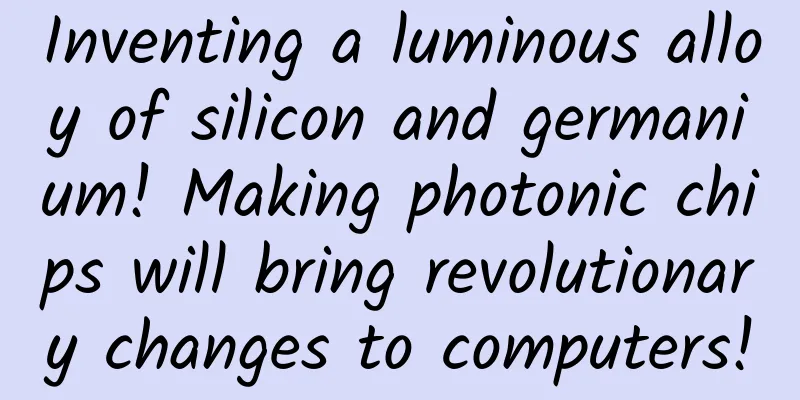Inventing a luminous alloy of silicon and germanium! Making photonic chips will bring revolutionary changes to computers!

|
[Mobile software: Bo Ke Yuan] If computers use photons instead of electrons to transmit data, they will perform better and consume less power. Scientists are currently working on a new light-emitting alloy of silicon and germanium to obtain photonic chips, which will bring revolutionary changes to computers. Photons, the particles that make up light, have basically replaced electrons for data transmission in communication networks. The high bandwidth of optical signals has driven the huge growth of telephone systems, television broadcasting and the Internet, however, photons have not yet replaced electrons in computers. Using light to carry data across processor chips and their interconnections would dramatically increase the speed of computers (communication within and between chips could be increased by a factor of 1,000) while reducing the power required to run them. Advanced microprocessor chips can contain tens of billions of transistors, and their copper electrical interconnects generate a lot of heat when they operate. Unlike photons, electrons have mass and charge. When they flow through metal or semiconductor materials, they are scattered by silicon and metal atoms, causing them to vibrate and generate heat. As a result, much of the power supplied to the microprocessor is wasted. The challenge of producing light from silicon The electronics industry is gearing up to use silicon in computer chips because of its superior electronic properties and availability. It's a good semiconductor, an abundant element, and, like silicon oxide, a component of glass and sand. However, due to silicon's crystal structure, it's not very good at processing light. For example, it can't generate photons or control their flow for data processing. Scientists have studied light-emitting materials such as gallium arsenide and indium phosphide, but their use in computers remains limited because they don't integrate well with current silicon technology. Optoelectronic chips Scientists from Europe have published in the journal Nature a new alloy of silicon and germanium that is optically active. "This is the first step. We have shown that this material is very suitable for emitting light and that it is compatible with silicon," said Jos Haverkort, a physicist at the Eindhoven University of Technology in the Netherlands. The next step is to develop a silicon-compatible laser that will be integrated into electronic circuits as a light source for optoelectronic chips, which is the ultimate goal of the SILAS project supported by the EU FET program. The team was led by Erik Bakkers of Eindhoven University and included researchers from the universities of Jena and Munich in Germany, the University of Linz in Austria, the University of Oxford in the UK and IBM University in Switzerland. To create the laser, the scientists combined silicon and germanium in a hexagonal structure that can emit light, overcoming the disadvantage of silicon, in which atoms are arranged in a cubic form. It was a difficult project, and initial attempts to coax silicon into adopting a hexagonal structure by depositing silicon atoms on a hexagonal germanium layer failed. "When silicon is grown on flat hexagonal germanium, it stubbornly refuses to change its cubic structure," explains Jonathan Finley from the Technical University of Munich. Finley was able to work out this unusual growth of silicon-germanium by measuring the optical properties of the resulting silicon samples. Over the years, however, the Eindhoven University research group had developed expertise in growing nanotubes and reasoned that what didn't work on a flat surface of germanium might work on the curved surface of a nanotube, and this time the matter was resolved. What was done was to use gallium arsenide nanowires, which have a hexagonal structure, so there's a hexagonal stem, and the researchers created a silicon shell around the core, which also has a hexagonal structure. By varying the amount of silicon and germanium deposited on the nanotubes, the researchers found that when the concentration of germanium exceeded 65 percent, this hexagonal alloy was able to emit light. The next step is the demonstration of lasing, in other words, determining how well the silicon-germanium alloy can amplify and emit light as a laser, and measuring it. There are several outstanding issues that need to be addressed before silicon germanium can be fully integrated with silicon-based electronics: First, these devices must be integrated with existing technologies, which remains a hurdle. It is expected that future quantum computers will use low-cost silicon-based LEDs, fiber lasers, light sensors, and light-emitting quantum dots, among other applications. Overall, the shift from electrical to optical communications will drive innovation in many areas, from lidar for autonomous driving to sensors for medical diagnostics or real-time air pollution detection. |
Recommend
Why do products searched on JD.com appear in Douyin ads?
I often hear friends around me say: WC, Toutiao w...
The most comprehensive in history: 37 ultimate promotion and operation methods for domestic apps
In a word, there is no more comprehensive summary...
iOS/iPadOS 14 beta 2 is released. What are the new improvements and features?
Following the release of the first developer beta...
Burning money, poaching anchors, and high bandwidth fees, how do live streaming platforms achieve commercial monetization?
Today, let’s talk about how the live streaming in...
4 dimensions, detailed explanation of refined operations!
The mobile Internet attaches more importance to t...
How to Use Push Notifications in iOS 10
Introduction Although often overused, push notifi...
Samsung's unreleased TV preview: finally able to play happily with mobile phones
After learning that Samsung's heavyweight SUH...
How to write a good advertising case analysis? Three simple steps to tell you
During the holidays, a reader asked me a question...
Live broadcast methodology in the automotive industry!
Today we will use the automotive industry as an e...
The fresher the food, the better? These foods are not good if they are too fresh!
This issue is planned: 91, Little Dandelion This ...
How many "different worlds" can a mountain separate?
The mountains stretch north and south It created ...
Photoshop Art Title Design Course
Photoshop Art Title Design Course Resource Introd...
How much does it cost to develop a mini program in Guangzhou?
In an era when smartphone use has become a daily ...
The ancestor of shuttlecock kicking is actually football?
Window of Intangible Cultural Heritage Shuttlecoc...
Why are Huawei and Alibaba employees boycotted for switching to Microsoft? What is the specific situation?
Why are Huawei and Alibaba employees boycotted fo...









